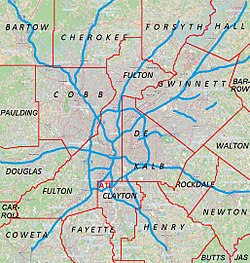Glenridge Hall
Glenridge Hall | |
Formerly listed on the U.S. National Register of Historic Places | |
| Location | 6615 Glenridge Drive Sandy Springs, Georgia, United States |
|---|---|
| Coordinates | 33°56′17.34″N 84°21′51.912″W / 33.9381500°N 84.36442000°W |
| Built | 1929 |
| Architect | Samuel Inman Cooper |
| Architectural style | Tudor Revival |
| NRHP reference No. | 82002418 |
| Significant dates | |
| Added to NRHP | June 17, 1982 |
| Removed from NRHP | September 17, 2015 |
Glenridge Hall was a historic property in Sandy Springs, Georgia, United States. The house was built in 1929 and listed on the National Register of Historic Places in 1982. The site was demolished and delisted in 2015.
History
[edit]Glenridge Hall was built by Atlanta businessman and co-founder of Georgia Power[1] Thomas K. Glenn in 1929. Located on 400 acres (160 hectares) of farmland north of Atlanta in what is now Sandy Springs, the Tudor Revival house was designed by Atlanta architect Samuel Inman Cooper and required approximately a year for 60 men to build. The house would serve as Glenn's residence until his death in 1946.[2] Starting in the early 1980s, Glenn's granddaughter began to restore the house, and it was listed on the National Register of Historic Places in 1982.[3] In the following years, the building was used for many charitable events and fundraisers, and it was used as a filming location for such films and series as Driving Miss Daisy and The Vampire Diaries.[3]
By Summer 2014, only about 80 acres (32 hectares) of the original property remained part of the estate.[2] In July of that year, the property was put up for sale.[4] Later that year, the Georgia Trust for Historic Preservation placed the property on its 2015 list of Places in Peril.[5] In 2015, it was announced that the house would be demolished to make way for Mercedes-Benz's U.S. headquarters and for residential developments by Roswell, Georgia-based homebuilding company Ashton Woods.[3] Following this announcement, historic preservationists in the area voiced their objection to the house's destruction, and they created a petition on Change.org arguing against its destruction.[6] By April 2015, the petition had over 15,000 signatures.[7] Despite this, the mansion was demolished on April 9.[7]
See also
[edit]References
[edit]- ^ "PHOTOS: Glenridge Hall over the years". The Atlanta Journal-Constitution. Cox Enterprises. Archived from the original on February 20, 2018. Retrieved August 26, 2020.
- ^ a b "Glenridge Hall". Georgia Trust for Historic Preservation. October 10, 2015. Archived from the original on August 10, 2022. Retrieved August 26, 2020.
- ^ a b c Dixon, Kristal (March 30, 2015). "Report: Glenridge Hall Set To Be Demolished". Patch. Archived from the original on October 17, 2021. Retrieved August 26, 2020.
- ^ Sams, Douglas (July 1, 2014). "More than 70-acre Glenridge Hall site hits the market". Atlanta Business Chronicle. American City Business Journals. Archived from the original on January 11, 2015. Retrieved August 26, 2020.
- ^ Dixon, Kristal (October 29, 2014). "Glenridge Hall Named to 2015 Places of Peril List". Patch. Archived from the original on November 9, 2014. Retrieved August 26, 2020.
- ^ Trubey, J. Scott (September 24, 2016). "Development at Glenridge Hall, Mercedes HQ outlined". The Atlanta Journal-Constitution. Cox Enterprises. Retrieved August 26, 2020.
- ^ a b Johnston, Andy (September 24, 2016). "Actual Factual Georgia: Glenrigde Hall more than vampire domicile". The Atlanta Journal-Constitution. Cox Enterprises. Retrieved August 26, 2020.
Further reading
[edit]- Garrard, Deborah (September 24, 2016). "Heart-sore over Glenridge Hall". The Atlanta Journal-Constitution. Cox Enterprises. Retrieved August 26, 2020.


 French
French Deutsch
Deutsch

